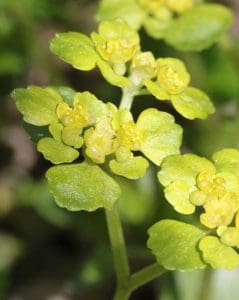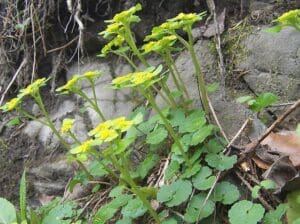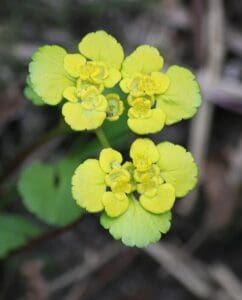Alternate-leaved Saxifrage / Spring / Summer / Autumn / Winter / Edible
There are a couple of types of Saxifrage, they all tend to grow in woodlands and provide good foraging through all seasons. Typically slightly dry but a nice addition to most dishes.
Common Names
Alternate-leaved Saxifrage
Botanical Name
Chrysoplenium alternifolium
Scientific Classification
Kingdom – Plantae
Order –Saxifragales
Family – Saxifragaceae
Physical Characteristics of Alternate-leaved Saxifrage
Low growing, often forming dense mats of foliage and flowers.
Leaves
The leaves associated with the flowers are very similar indeed to Opposite-Leaved Golden Saxifrage. The leaves on the stem are alternate, but the most obvious difference between these two plants are the base leaves. They are cordate, (heart shaped), and have a much larger petiole attaching it to the stem.
Flowers
As above but slightly larger, 5-6mm across.
As the name suggests, it is the leaves associated with the flowers in both of these species that are golden, not the flowers themselves.
Habitat
Both Saxifrage species like woodland flushes, stream sides, wet springs, wet rocks on acid rocks and are often found growing together. Alternate-leaved Saxifrage is slightly more restricted to base-rich moving ground water and also likes upland mossy flushes.
Known Hazards
None known for the plant itself, but it’s worth reading up about Liver fluke as growing in very damp environments this could be something to be wary of, we have a nice piece on liver fluke right here
Could be confused with
There’s really not much this low growing plant could be confused with apart from Opposite-leaved Golden Saxifrage, (which is also edible) especially once you know where to look for it.
Edible Use
The leaves of both Opposite and Alternate leaved Saxifrage make a nice addition to a salad. They taste a little peppery with a nice crunch. Some folk find them slightly bitter, but mixed through a salad with other greens, this is not an overwhelming flavour. It could also be added to pestos, smoothies, juices and used as a pot herb.
Use a sharp knife to cut the stems of the plant, otherwise you’ll end up with lots of muddy roots amongst your greens. Wash the leaves well before consumption, again, they’ll likely be a bit muddy due to the nature of where they like to grow.
Notes on Herbal uses
None known
Extra notes from the Foragers
There is no apparent folklore associated with Golden-leaved Saxifrage, although Chrysoplenium oppositifolium is the county flower of Clackmanannshire in Scotland. I did try to do some digging to find out why it was chosen but came to a dead end.
The etymological root of the binomial name Chrysoplenium is derived from Latin chrysitis meaning ‘golden’ and spen meaning ‘spleen’. This refers to the flowers which are golden in colour and with no petals, which is possibly where the spleen part of the name comes from. The species name of both plants in this genus is self explanatory and refers to the leaves, folium, foliage and alternate or opposite. So opposite leaves or alternate leaves
References
https://thehazeltree.co.uk/2018/04/06/golden-saxifrage/
https://wildflowerfinder.org.uk/
https://paulkirtley.co.uk/2011/foraging-early-spring-greens/
http://www.naturalmedicinalherbs.net/herbs/c/chrysosplenium-alternifolium=golden-saxifrage.php








